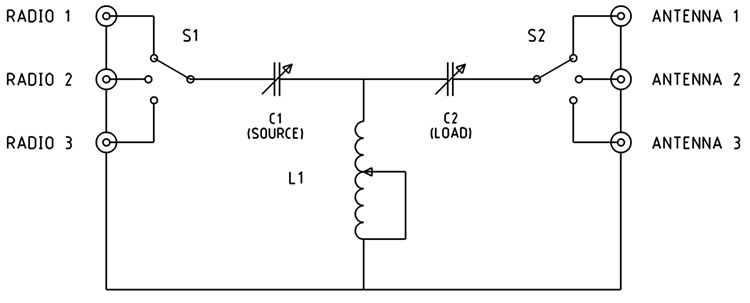Tag: am
21 November 2013 » CCRadio EP portable
CCRadio-EP AM/FM Portable - A Bob Grove What’s New Review
Larry Van Horn, New Products Editor
While it may seem strange that we would be reviewing anything as plebian as an AM/FM portable radio, there is a method to our madness. For several years, GE offered their “Superadio” to the consumer market; it had good sound, sharp AM selectivity, and external antenna connections. The radio sold in the $50-$60 range, and was very popular with domestic AM broadcast DX- ers. When it was discontinued, we had a surge of inquiries for a replacement, but none was to be found. Will the new CCRadio-EP be the answer?
The radio has decent sound, good AM selec- tivity, wide/narrow FM selectivity, and external antenna connectors. It has the traditional, analog, slide-rule tuning dial which may be backlit for night viewing.
Its 4-inch, self-contained speaker delivers room-filling sound with notable bass and clean highs with minimal distortion. Separate bass and treble controls invite custom high/low roll-offs to suit the listener’s preference. If you have a set of stereo headphones, a stereo output jack provides that listening mode as well. There is also a line-in jack in case you have a personal MP3 or other player that you’d like to hear through a larger speaker.
The radio runs on either four D cells (not included) or a 120 VAC/6 VDC wall adapter (included). A snap-up/snap-down carrying handle facilitates transport.
The CCRadio-EP is simple to operate and should appeal to techie types with its unique “Twin Coil Ferrite” AM fine tuning knob. This is an RF peaking adjustment for the antenna input, depending on the frequency being received. It works with both the internal and external antenna.
It appears that the choice of external an- tenna is rather critical, and experimenting with optimum length and placement may be necessary to avoid “swamping” that tuning circuit, as well as avoiding common mode (ground loop) hum. I suspect that a shorter outdoor wire antenna would be better than a long one.
The internal ferrite loop antenna remains in service with the external antenna attached. If you were experiencing electrical noise interfer- ence, it will still be there, hopefully attenuated somewhat by stronger signal strengths brought in by the outdoor wire. It is advisable to attach a ground wire to that respective terminal as well to avoid AC hum and other electrical line noise. If such interference persists, battery operation and/ or relocation of the radio are recommended.
An FM internal/external switch allows selection of an outdoor antenna via a TV-style F connector. The benefits and disadvantages of high sensitivity become immediately apparent when switching between antennas. With the radio’s telescoping whip, distances of up to 100 miles are readily received at my location; switching to an external beam, strong signal overload clouds reception of weaker signals.
The AM wide/narrow IF filter selection is appropriately labeled “Music” and”Voice.” The wide bandpass allows more highs for in- creased music fidelity, while the low bandpass restricts the bandwidth to reject the frequencies not required for speech reception. Additionally, the independent bass and treble controls have a profound effect on emphasizing or attenuating the high and low audio frequencies.
The accuracy of the printed frequency dial on our particular sample was excellent for FM, but rather arbitrary for AM. Of course with any analog-dial AM/FM radio, you tune for best reception, not for what the print on the dial says.
The CCrane Radio-EP has good sensitivity and the 4-inch speaker delivers credible sound, enhanced by the separate treble and bass controls. Its AM selectivity switch is very effective for reducing adjacent channel interference. FM sen- sitivity is excellent, providing distant reception through its telescoping antenna.
With so many off-the-shelf AM/FM radios now readily available from chain stores and at widely disparate prices, it’s hard to compare them fairly. Taking the radio at its face value – an AM/ FM portable with good sound and sensitivity – the CCrane Radio-EP does its job well.
| CCrane Radio-EP lists for $69.95 from |
| C. Crane Company, Inc., |
| 1001 Main Street, Fortuna |
| CA 95540, (800) 522-8863 |
| http://www.ccrane.com/radios/am-fm-radios/ccradio-ep.aspx |
21 November 2013 » Tuned Loop AM Antenna
Parts
- amateurradiosupplies Copper Antenna Wire - 100 Feet - $26
- amateurradiosupplies Budwig End Insulator
- amateurradiosupplies Dogbone Insulator
- amateurradiosupplies No. 18 AWG CopperWeld Antenna Wire - 50 FT
- Wireman - 501 - 18 AWG solid copper-clad steel
- Wireman - 890 PULLEY, 3/4” - marine type, swivel - for 3/32” - 3/16” rope
- Wireman - 810 Budwig brand end insulators, HQ-2. Fiberglass-reinforced ABS plastic
- Wireman - 813 End insulator (pair), 3” mineral filled acrylic
- Parts Express - magnet wire
Modify that AM antenna by Bruce Carter
Modify that AM antenna by Bruce Carter
Nice article, with # loops vs. area table.
Tune your antenna for better DX - Construction of random length wire AM antenna
Tune your antenna for better DX
by Roy A. Walton (adapted by Bruce Carter)
If you use a “Pi-Section Coupler”, your antenna can be as short as 30 feet or as long as 100 feet. The combination can be made to work efficiently at all frequencies between 500 and 6800 kHz.
A MAGNETIC LOOP ANTENNA FOR SHORTWAVE LISTENING (SWL)
A MAGNETIC LOOP ANTENNA FOR SHORTWAVE LISTENING (SWL)
The PVC Loop Overall Article
Article
How to build a tuned loop antenna
http://www.iw5edi.com/ham-radio/?how-to-build-a-tuned-loop-antenna,118
Chris Ridley - BUILD A TUNED LOOP
How can you vastly improve your Medium Wave reception? its quite simple really, all you need is 120 foot of wire, a few lengths of timber and an old tuning capacitor with which you can build the answer to every DX’ers prayers, a tuned loop antenna.
MTM Scientific, Inc… AM Radio Loop Antenna
Our AM RADIO DX LOOP ANTENNA converts your portable transistor radio into a long distance receiver
Pickup Loop for AM Loop Antenna
The coupling from the antenna to the radio is through the ferrite loop antenna inside most portable AM radios. We have received several inquries about the possibility of conneting the antenna to a regular component receiver. Although every situation is different, it is generally easy to do.
Review - MTM Scientific AM Loop Antenna
The MTM Scientific AM Loop Antenna is quite a different animal from all of those however for a few reasons. First it is a large square wood frame loop measuring slightly over 17” per side which makes it at least twice the size of the other passive AM loops I mentioned. This seemed like an exciting prospect as it seemed likely it would be able to capture more signal than the smaller loops.
Loop Antennas
A loop antenna is a small multi turn loop of less than 1/10th wavelength in length. The loop is wound on a form, which may be either box (solenoid), or spiral (pancake) wound. The core material can either be air, or a powdered iron compound (Ferrite). The gain of a loop is much less than a longwire, but it has much less noise pickup. A properly designed Loop primarily responds to the magnetic component of the radio wave. Note that noise resides primarily in the electrical component. A vertical antenna responds mainly to the electrical component.
Photos of PVC Loop antennas
A loop antenna is an antenna primarily for the AM broadcast and the Longwave bands.
Loading Inductors
The Radio Board - Loop antenna questions
exray
I think the generalization about ‘how many feet’ is more of a ballpark consideration. If you’re using a typical BCB range tuning cap like 365-400pf you’re going to fall into the 50-75 ft range almost inherently for most practical sizes and thats never been a bad thing.
Now if you want to use something like 200 feet of wire (a la some of these wacky broomstick or liter-coke bottle ideas) and find a cap to tune it with you’ll immediately see the uh-oh at 1700 kcs. And the other extreme…20 feet of wire at 550kc.
That said, you’ll run into the unavailability of standard parts and having to multi-bandswitch the thing to cover BCB probably before you will encounter the differences in actual peformance.
If you are building a 2-3’ size loop with a typical BCB cap you can tune the entire range without tapping it. The difference in wire length should not be noticeable.
Medium Wave One Tube Loop Radio
I am proud to introduce you to my first loop tube radio. I had this in mind for a while and it took me a long time to get started. The radio design was simple, but how was I to make this into another show piece radio? Do I make it into a 1920’s look, or a rock n’ roll 50’s radio? This one is both. The design, and parts are something that you might have seen in a 1950’s Poptronics magazine. Then there are some hints that have that definite roaring 20’s look. The loop itself is an example as well as the art deco Garolite® front panel. The wood base gives this radio a breadboard look. I sure did it all. This puppy kept me up nights thinking how I was going to build her. I like that curve that decorates the front panel. I used a large pizza pan as a guide.
The radio is a simple regenerative type using a 6418 subminiature tube. This is a pentode tube that has a 30 volt plate maximum rating. The filament runs on 1.25 volts at 10ma. With 18 volts on the plate and a low current filament, the batteries will last a long time.
16 November 2013 » Random Length AM Antenna
Freq. / Wavelength
λ1 = 3*10^8 m/s/1.6*10^6 Hz = 187.5 m shortest wl
λ2 = 3*10^8 m/s/5.5*10^5 Hz = 545.5 m longest wl
| Frequency | Wavelength Meters | Wavelength Feet |
| 550k | 545m | 1788ft |
| 1600k | 187m | 614ft |
Links
Info
Parts
- amateurradiosupplies Copper Antenna Wire - 100 Feet - $26
- amateurradiosupplies Budwig End Insulator
- amateurradiosupplies Dogbone Insulator
- amateurradiosupplies No. 18 AWG CopperWeld Antenna Wire - 50 FT
- Wireman - 501 - 18 AWG solid copper-clad steel
- Wireman - 890 PULLEY, 3/4” - marine type, swivel - for 3/32” - 3/16” rope
- Wireman - 810 Budwig brand end insulators, HQ-2. Fiberglass-reinforced ABS plastic
- Wireman - 813 End insulator (pair), 3” mineral filled acrylic
- Parts Express - magnet wire
Collected Posts
Instructions for Putting up a Long-Wire Antenna
Instructions for Putting up a Long-Wire Antenna


Can you hang a random length wire outside? - Timbo in Oz
Posted by Timbo in Oz (A) on November 15, 2007 at 14:21:35
In Reply to: Antennae loop posted by sown gi on November 15, 2007 at 13:12:51:
use one side of some twisted 300 ohm ribbon as the down lead into the house and to the tuner, connect that side to the AM post and t’other to the gnd post.
then report back. the 1500 IIRC has a decent AM stage.
And one other thing, IF it did originally came with a very small loop, then you may NEED one connected to make the longish random work! OFTEN stated in the manual and true IME
most audio repair shope should have a few Small AM loops lying about.
You realy do still need an aerial as well, this is just a good ground
You realy do still need an aerial as well, this is just a good ground
Posted by Timbo in Oz (A) on November 16, 2012 at 13:57:34
In Reply to: That IS interesting, thanks! posted by 1973shovel on November 10, 2012 at 06:54:24:
A random wire (with a good ground) tuned - by a cap and a tapped coil - to each station - or broadly tuned to cover the ones you want (like mine is) will be a good deal better than just a good ground.
MUCH quieter as the AM stage’s own AGC will cope with the higher input.
A multi-use Antenna Tuner
Antenna Tuning Unit
MDS975 - ATUs - ANTENNA TUNING UNITS
Below is the circuit diagram for my preferred choice of a T type circuit which includes a variable attenuator and which could not be simpler to construct. This circuit, with the coil described, covers from 500kHz medium wave to 30MHz short wave. Tuning capacitor VC1 is adjusted to match the aerial side while tuning capacitor VC2 is adjusted to match the receiver side. This circuit is often referred to as a TRANSMATCH, particularly in the USA.
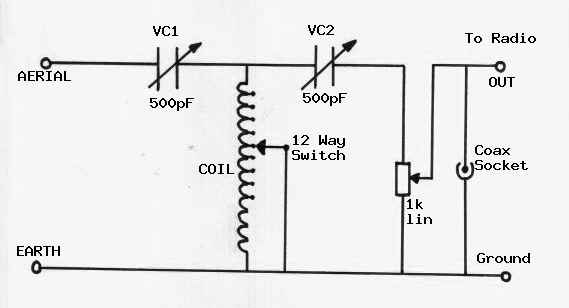
My rooftop AM antenna - youtube
My rooftop AM antenna - youtube
Midnight Science Catalog - Capacitor, 365 air variable
Capacitor, 365 air variable
As the surplus for 365pf caps has dried up, these little beauties were getting harder and harder to find. Not anymore! The Society now has a plentiful supply; we have them manufactured. They are brand new caps, 31 blade, .010-air-gap, 1/4” tuning shaft, and CW rotation decreases capacitance. Testing indicates a capacity range of 390 (fully meshed) to 16 pf (fully open). Shaft accommodates the point knob shown (sold separately), and a reduction drive for slower tuning (also sold separately).
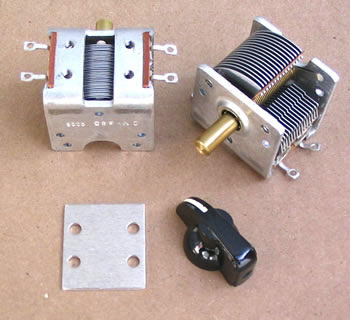
AM BAND ANTENNA TUNER KIT
This AM Band Tuner will work with most any crystal radio set. Tuners are attached to the antenna and inductively couple the signal captured into your crystal radio set. By adding the tuner to your station, selectivity and volume can generally be improved.
The backside of the tuner is shown at right. A dual-gang 365 pf capacitor is used to resonate the tuner coil and the antenna system as a whole. The result is an increase in the signal gleaned from the antenna and coupled to the set magnetically. The tuner uses a 6 by 5 inch front panel and a 6 by 8 in chassis. Two switches are used to configure the tuner. In addition, a nylon shaft is added to the tuning capacitor to reduce “hand capacity” while tuning. Kit time is less than one hour experienced builder and should add performance to your crystal radio station.

Variable Capacitors & Reduction Drives: Using, Mounting & Wiring.
Variable Capacitor Use Article
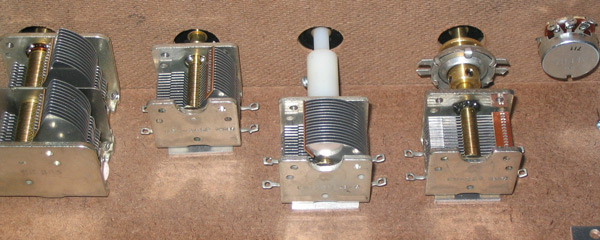
T-MATCH ATU
The T-Network Antenna Matching Unit
Homebrew Antenna Tuner - Steve Yates - AA5TB
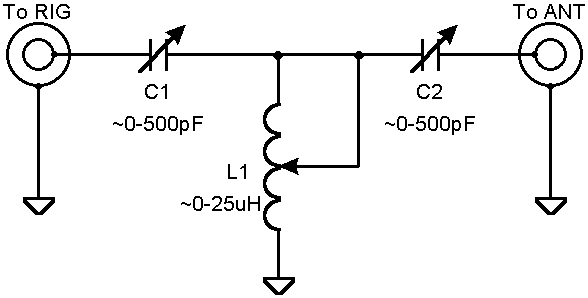
Tags
- linux
- debian
- diy
- arduino
- cellphone
- turntable
- antenna
- diy_audio
- led
- rune_audio
- tuner
- chipamp
- raspberry_pi
- bluehost
- am
- mpd
- developers_to_watch
- beaglebone
- stereo_system
- headphone_amp
- i3wm
- fm
- arch_linux
- bluetooth
- nas
- preamp
- git
- javascript
- sql
- ti_cc_3000
- wifi
- reactor_safety
- volumio
- raspbian
- pptp
- Debian
- keyboard
- portable
- lp_storage
- firefox_phone
- firefox_os
- repair
- radio
- moteino_home_automation
- xmonad
- gitlab
- rails
- rails-api
- windows_os
- vm_host
- virtualbox
- electronics
- cubox
- rhombic_antenna
- diy_li_ion_battery_pack
- survival
- music_player
- headphones
- robotics
- welcome
- speaker
- subwoofer
- tear_drop_trailers
- philips_cd935
- diy_cabling
- laptop
- pickup
- hurricane_lantern
- coding
- cd_player
- bluez
- programming
- headset
- hardware_hackers
- arduino_ide
- tube_audio
- porch_steps_led
- ebay
- fm_transmitter
- coax_power_plug
- recipe
- vpn
- arduino_radio
- tv
- gammu
- stereo_receiver
- seamonkey
- thunderbird
- vinyl_lp
- cleaning
- hardware
- rs232
- max232
- gogs
- job_hunt
- phusion_passenger
- tuned_loop
- firefox
- icemonkey
- job_skills
- webmail
- spam_assassin
- irc
- security
- pc_audio
- green_chile
- moosefet
- usb
- ajax
